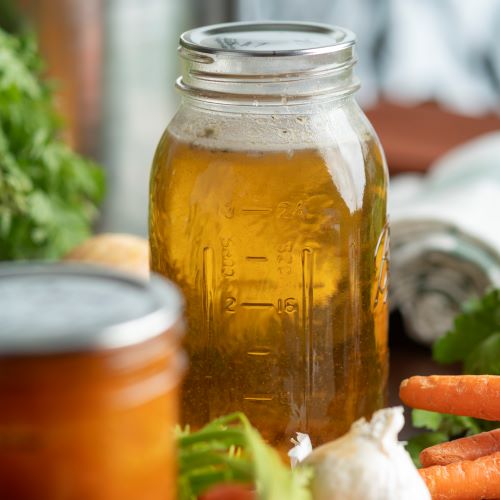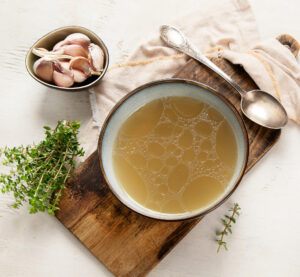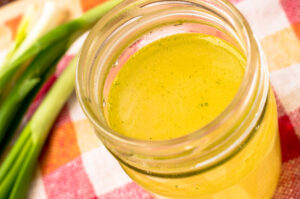Check this out!
Broth and stock are the unsung heroes of the kitchen, forming the foundation of countless soups, stews, sauces, and gravies. While the terms are often used interchangeably, there are distinct differences in flavor, texture, and culinary application. Understanding how stock and broth differ—and when to use each—will not only elevate your cooking but also help you get the most out of every ingredient in your kitchen. Whether you’re simmering bones for a rich stock or creating a lighter broth for everyday recipes, both play an essential role in home cooking and food preservation.
I sometimes use affiliate links in my content. This will not cost you anything but it helps me offset my costs to keep creating new canning recipes. Thank you for your support.
By Diane Devereaux, The Canning Diva®
Last updated: October 1, 2025
The Difference Between Broth and Stock
Broths and stocks are mainstays in our kitchens as they are the foundation, or building blocks, for so many recipes, especially when making soups and stews. Understanding their differences and similarities will help you decide which is best to use in a particular recipe and may also dictate what you decide to preserve versus purchase. While the term “stock” and “broth” are often used interchangeably, within the culinary world there is a distinct difference.

Stock
Stock is the key player in many classic cuisines and is the basis for which almost every sauce and stew is created. Stocks are rich in flavor and are used to enhance the natural juices of beef, chicken, pork and fish dishes. For instance, my Chicken Tortilla Soup recipe specifically calls for stock over broth. The depth and flavor profile of a stock is achieved by using roasted bones, mirepoix (onions, carrots and celery), aromatic vegetables and seasonings like garlic and fresh herbs.
What sets stock apart from broth is the roasting and lengthy simmering of bones from animals or fish. It is the marrow and collagen from bones that give stock its distinct flavor and a gel-like consistency. It is this body and depth that is transferred into every recipe where stock is used. And for the record, “bone broth” is actually stock.
And, for the record, “bone broth” is actually stock.
Broth
Broth has a broader use in the home kitchen than stock as you will find it called for in the creation of many side dishes like rice or couscous, mashed potatoes, stuffing and when creating thinner-based soups. Broth usually replaces water when cooking. When creating broth although we use meat and bones, they are not roasted, just added raw to the stock pot and then simmered with fresh herbs, mirepoix and water for much less time than stock.
Which Should I Use?
There is no wrong use of either stock or broth. However, your choice may come down to cost, time, and availability. For this chapter, I created a variety of soups and stew recipes you may preserve to enjoy at a later date. You will notice when I want a thicker stew or soup base, or I use a seared meat, the recipe calls for stock. When you want to add flavor to a dish that uses beans or starch as a thickener, the recipe calls for broth.
If any recipe calls for stock and you only have broth on hand, use it. The recipe will still taste delicious! Where you can noticeably tell a difference in flavor is when you use plain water instead of a stock or broth. The depth and body of the overall recipe depends on the use of stock or broth, unless, of course, the ingredients make their own broth while they cook. In that case, just adding water makes sense.

Vital Steps for Making Stock
Because we are using bones from lamb, beef, chicken, pork, veal, and fish to create various stocks in this chapter, you must first follow these vital steps to ensure the bones have been properly prepared to yield the best results.
- Roasting and Sweating
While it sounds like a lot of work, this crucial step holds all the cards with respect to flavor. Depending on the type of stock you are making, roast bones of chicken, lamb, beef, veal, and pork as well as shellfish shells in an oven until deeply browned but not burnt. Roasting vegetables when creating vegetable stock is the key element giving an all vegetable stock its robust flavor.
Fish heads and bones are gently cooked in a covered pot (a process known as sweating) prior to simmering. Make a thin layer of mirepoix and herbs in a pot, add the fish heads and bones, pour in some dry white wine, and then cover the pot with a lid. Cook gently over medium heat in a covered pot until the flesh clinging to the bones becomes opaque before adding water to simmer. Click here for a pressure canning recipe to preserve Fish Stock to use as a soup base. - Time
With the exception of Fish Stock, do not rush the simmering process. Many chefs leave their stocks to simmer on low overnight for 8 to 12 hours before straining. While my stock recipes state to simmer for 6 hours, feel free to simmer for several hours longer. - Do Not Disturb
The key to making the best stock is to rarely if ever interrupt the stock while it is simmering on the stovetop. Removing foam and debris at the surface is acceptable, however with the exception of a few initial and concluding stirs, leave your stock uninterrupted. Doing so allows us to extract as many nutrients and important collagen from the bones as possible. - The Strain
Some chefs go to the extreme, straining their stock upwards of 40 times to obtain the “perfect” stock free of any debris. To me, that level of straining is a real strain on my patience, and, while I give kudos to them, I am content with minute debris. At minimum, strain your stock at least once prior to filling your jars; however, you may restrain and strain again as many times as your heart desires.
Bringing It All Together
Whether you’re preparing a rich, collagen-packed beef stock, a delicate fish stock, or a lighter vegetable broth, the goal is the same: to build depth of flavor that elevates your cooking. Stock offers body and richness from simmered bones, while broth delivers a lighter, everyday option that still infuses dishes with flavor. Both are staples every home cook should master.
By taking the time to roast bones, sweat vegetables, and simmer patiently, you ensure your stock is as flavorful and nutritious as possible. Meanwhile, broth provides a quicker solution when you need versatility and convenience. Understanding the difference between broth and stock allows you to make the right choice for soups, stews, sauces, and even side dishes, giving every recipe a homemade touch.
The next time you’re cooking, consider whether the recipe calls for the richness of stock or the lighter profile of broth. Knowing when to use each—and how to prepare them well—will transform your meals from simple to extraordinary.
People Often Ask
A: Yes, in most recipes you can substitute broth for stock. While stock tends to have a richer flavor and thicker body because of the collagen from bones, broth will still provide excellent flavor in soups, stews, and sauces.
A: Despite its name, bone broth is technically stock. It’s made by simmering roasted bones with vegetables and herbs for long periods of time, creating the same collagen-rich body and depth of flavor that defines stock.
A: Both broth and stock are healthy, nourishing options. Stock has a slight nutritional edge due to the collagen, minerals, and amino acids extracted from bones, while broth is lighter and lower in calories.
A: Meat-based stock often gels when cooled because the simmering process extracts collagen from the bones and connective tissues. As the stock chills, the collagen sets into a natural gelatin. This gel-like texture is a sign of a nutrient-rich, well-made stock and will return to liquid once reheated.
A: Fish stock does not gel as firmly as meat-based stock because fish bones contain less collagen. Instead, fish stock has a lighter body and more delicate flavor. This makes it an excellent base for seafood soups, chowders, and risottos without overpowering the dish.
About the Author:
Diane Devereaux, The Canning Diva®, is an internationally recognized food preservation expert, author, and educator with over 30 years of home canning experience. She’s the author of multiple top-selling canning books and teaches workshops across the U.S. Learn more at TheCanningDiva.com.


